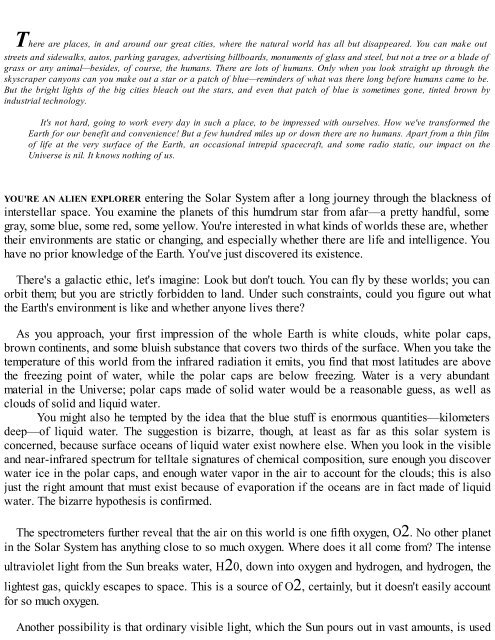Pale Blue Dot ( PDFDrive.com ) (1)
Create successful ePaper yourself
Turn your PDF publications into a flip-book with our unique Google optimized e-Paper software.
There are places, in and around our great cities, where the natural world has all but disappeared. You can make out<br />
streets and sidewalks, autos, parking garages, advertising billboards, monuments of glass and steel, but not a tree or a blade of<br />
grass or any animal—besides, of course, the humans. There are lots of humans. Only when you look straight up through the<br />
skyscraper canyons can you make out a star or a patch of blue—reminders of what was there long before humans came to be.<br />
But the bright lights of the big cities bleach out the stars, and even that patch of blue is sometimes gone, tinted brown by<br />
industrial technology.<br />
It's not hard, going to work every day in such a place, to be impressed with ourselves. How we've transformed the<br />
Earth for our benefit and convenience! But a few hundred miles up or down there are no humans. Apart from a thin film<br />
of life at the very surface of the Earth, an occasional intrepid spacecraft, and some radio static, our impact on the<br />
Universe is nil. It knows nothing of us.<br />
YOU'RE AN ALIEN EXPLORER entering the Solar System after a long journey through the blackness of<br />
interstellar space. You examine the planets of this humdrum star from afar—a pretty handful, some<br />
gray, some blue, some red, some yellow. You're interested in what kinds of worlds these are, whether<br />
their environments are static or changing, and especially whether there are life and intelligence. You<br />
have no prior knowledge of the Earth. You've just discovered its existence.<br />
There's a galactic ethic, let's imagine: Look but don't touch. You can fly by these worlds; you can<br />
orbit them; but you are strictly forbidden to land. Under such constraints, could you figure out what<br />
the Earth's environment is like and whether anyone lives there?<br />
As you approach, your first impression of the whole Earth is white clouds, white polar caps,<br />
brown continents, and some bluish substance that covers two thirds of the surface. When you take the<br />
temperature of this world from the infrared radiation it emits, you find that most latitudes are above<br />
the freezing point of water, while the polar caps are below freezing. Water is a very abundant<br />
material in the Universe; polar caps made of solid water would be a reasonable guess, as well as<br />
clouds of solid and liquid water.<br />
You might also he tempted by the idea that the blue stuff is enormous quantities—kilometers<br />
deep—of liquid water. The suggestion is bizarre, though, at least as far as this solar system is<br />
concerned, because surface oceans of liquid water exist nowhere else. When you look in the visible<br />
and near-infrared spectrum for telltale signatures of chemical <strong>com</strong>position, sure enough you discover<br />
water ice in the polar caps, and enough water vapor in the air to account for the clouds; this is also<br />
just the right amount that must exist because of evaporation if the oceans are in fact made of liquid<br />
water. The bizarre hypothesis is confirmed.<br />
The spectrometers further reveal that the air on this world is one fifth oxygen, O2. No other planet<br />
in the Solar System has anything close to so much oxygen. Where does it all <strong>com</strong>e from? The intense<br />
ultraviolet light from the Sun breaks water, H20, down into oxygen and hydrogen, and hydrogen, the<br />
lightest gas, quickly escapes to space. This is a source of O2, certainly, but it doesn't easily account<br />
for so much oxygen.<br />
Another possibility is that ordinary visible light, which the Sun pours out in vast amounts, is used


